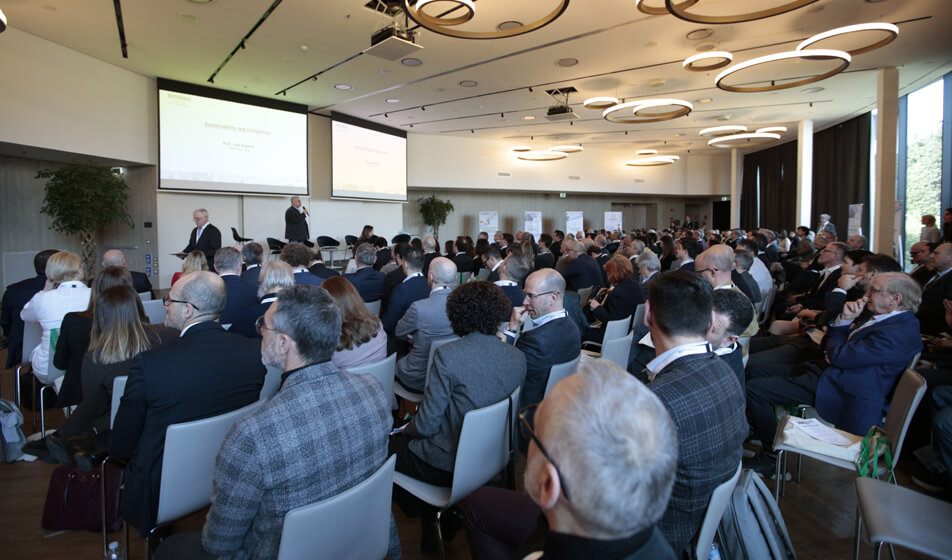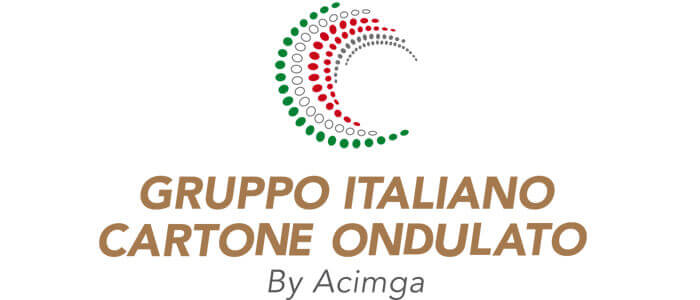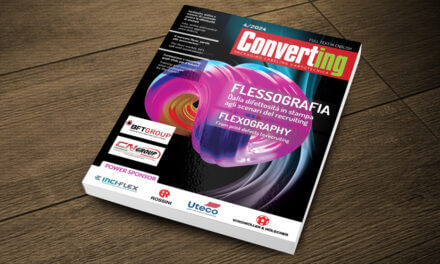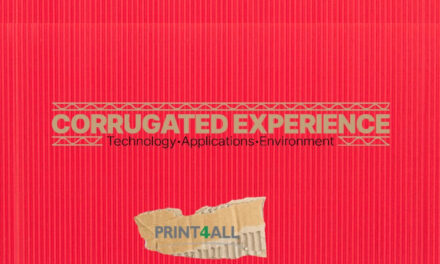The third edition of Roto4All organised by Acimga’s Italian Rotogravure Group brought together in Milan more than 250 operators in the supply chain and a group of students who are “bearers of future”. Together they witnessed a lively debate on the various applications, new materials and developments of a technology that, despite commonplaces, is experiencing a season of development.
The photos taken during Roto4All 2023 are those of a lively and well-participated meeting, which was characterised by a density of content never taken for granted in events of this kind. After the restrictions imposed by the Covid on the two previous editions, on 9 March the entire rotogravure community gathered at the Sheraton Milano San Siro in a meeting that unfolded the density of knowledge and the network of developments that this printing technique creates.
Enrico Barboglio, ACIMGA Director, and Gianmatteo Maggioni, Head of the Italian Rotogravure Group by Acimga, opened the sessions by updating about the activities of the two institutions and documenting the evolution of this industry.
According to ERA statistics, Italy is the second largest European country, after Germany, in terms of the number of roto printing plants and machines installed. Today roto is widespread in most of Asia, all of North America and some states in sub-Saharan Africa, with particularly lively growth – to name just the two largest markets – in India and Turkey (Exportplanning data). At a global level, Italy is the fourth largest exporter after China, Germany and Japan and, as the speakers at Roto4All have testified, gives rise to a highly evolved industry.
False myths and true perspectives
“Rotogravure is an old printing technique, linked to newspapers and periodicals and little used nowadays”… “it is only used to print large quantities”… “it uses solvent-based inks, so it is polluting and has a negative environmental impact”… “it does not adapt to new technologies that are increasingly hybrid and multi-process”… The statements made by the students of the “Packaging Specialist” and “Omnichannel Marketing” courses at the Istituto Tecnico Superiore Rizzoli in Milan, led by prof. David Serenelli, allowed us to take stock of what roto really is today, dispelling recurrent false myths and enabling us to frame its scope and prospects accurately. Carlo Carnelli, owner of ColorConsulting and Coordinator of the ACIMGA Technical Group, together with Ivano Andrighetto, Sales Manager Brofind, and Giacomo Truffi, Product Sales Manager BOBST, were in charge of this.
The discussion between students and technicians was effective and lively, and dispelled unfounded clichés and clarified ‘fundamentals’. The facts help: according to Pira Smithers, gravure accounts for 36% of the printing technologies globally used in packaging. In Europe, the number of installed machines is significant, especially in packaging and decorative: two segments, analysts point out, that are sure to expand and to drive further development of printing.
Sustainability: what printers demand
Professor Lutz Engisch of the Leipzig University of Applied Sciences presented a study on ‘Sustainability and Rotogravure’ that investigates the advantages of roto in terms of circular economy and documents, adopting LCA, its low environmental impact compared to other printing technologies (roto is listed as the most virtuous after digital processes).
Prof. Engisch also reported the results of a recent survey, in which 116 printers and suppliers commented on the sustainability of this technology. According to the respondents, the main progress was in the use of recycled materials, energy consumption and in reducing harmful emissions; electrolysis of trivalent chromium is perceived as the main disadvantage of roto, while the main advantage lies in the re-use of cylinders. In order of importance, the desired actions to further improve the sustainability of roto concern solvent recovery (remember that the survey was conducted in Germany where this practice is not widespread, Ed.), reducing the amount of ink used, replacing hexavalent chromium and reducing start-up waste.
The data on the use of cylinders, length of runs, types of printed media and their thickness are also very interesting.
Sustainability again: technological progress
The afternoon session kicked off with a contribution from Jan ‘t Hart, Project Manager of AIM (Association des Industries de Marque), the European institution that brings together the national brand industry associations, of which the italian Centromarca is also a member.
Jan ‘t Hart updated on the progress of the Update Holygrail 2.0 project to digitise waste management through Watermark technology. Carried out with the support of the Alliance to End Plastic Waste and more than 120 companies across the supply chain – from FMCG mega-brands to recyclers via technology providers – it is based on the ‘digital watermarking’ of plastic packaging to enable its automatic sorting at end-of-life and forwarding to the most appropriate disposal channels.
HolyGrail 2.0 has been validated under real operating conditions on a semi-industrial scale. The advancement is due to the packaging waste identification and sorting unit, now in pilot phase, developed by French manufacturer Pellenc ST in collaboration with digital watermark supplier Digimarc.
Besides, how would it be possible to ‘design sustainably’ without knowing how materials are recycled, with what organisational and technical limitations, and with what opportunities for evolution? And without clearly knowing what the market (consumers and brands) demands and how the laws that guide industry development interpret it? This was discussed by Felice Ursino, Innovation & QA Director Sacchital Group, and Osvaldo Bosetti, Plant Director Europe Goglio Group, interviewed by Converting Magazine editor-in-chief Elena Piccinelli on the topic of new sustainable materials. The two major converters talked about the problems and progress made on paper-based substrates (Sacchital) and on high-barrier plastics and laminates, even in the most challenging industrial processes (Goglio), with a final mention to the guidelines expressed by the fort draft of new European Packaging and Packaging Waste Regulation.
Finally, speaking of sustainability, an update on the controversial topic of hexavalent chromium used to coat roto printing rolls could not be missing. This was addressed by Michael Fuerholzer, Vice President Kaspar Walter GmbH, starting with the CTAC Authorisation for the use of this substance (deadline September 2024) to illustrate the solutions and possible alternatives offered by his company.
What the institutions are working on
The conference closed with a debate between Alberto Palaveri, President of Giflex, and Gianmatteo Maggioni representing ACIMGA’s Roto Group. They spoke about sustainability and circular economy in the production phases of flexible packaging, emphasising the value of collaboration between players and institutions and presenting the index of the white paper produced by the working table between the two associations. It will examine the entire life cycle of flexible packaging with the eye of the industry that must make the circularity of this artefact a concrete option, industrialisable in fact, and also economically sustainable for all players in the production-consumption chain.
A more international community
“This third edition of Roto4All has once again demonstrated how Italian rotogravure is a benchmark of excellence, a mature technology with a thousand very current applications and great dynamism”, says Enrico Barboglio, Director of ACIMGA. “The event was a great success, both in terms of the audience present and in terms of the content conveyed, and this is undoubtedly due to a cohesive rotogravure community, which invests in collaboration and the sharing of ideas, beyond the more usual parameters. Collaboration that also unites in general the vision of the Italian Rotogravure Group and ACIMGA, drivers of growth and interesting new activities, such as the agreement with ERA, the European Rotogravure Association, signed in February.



















